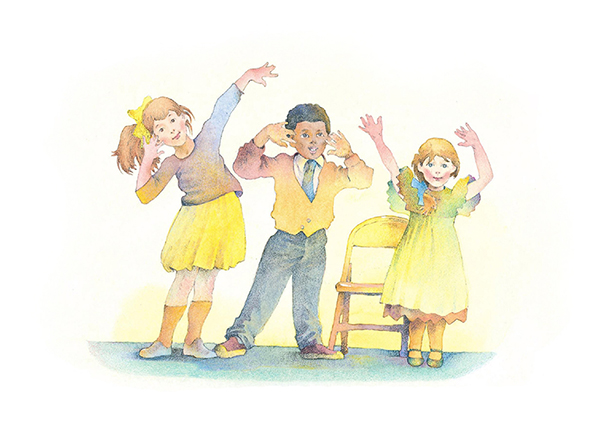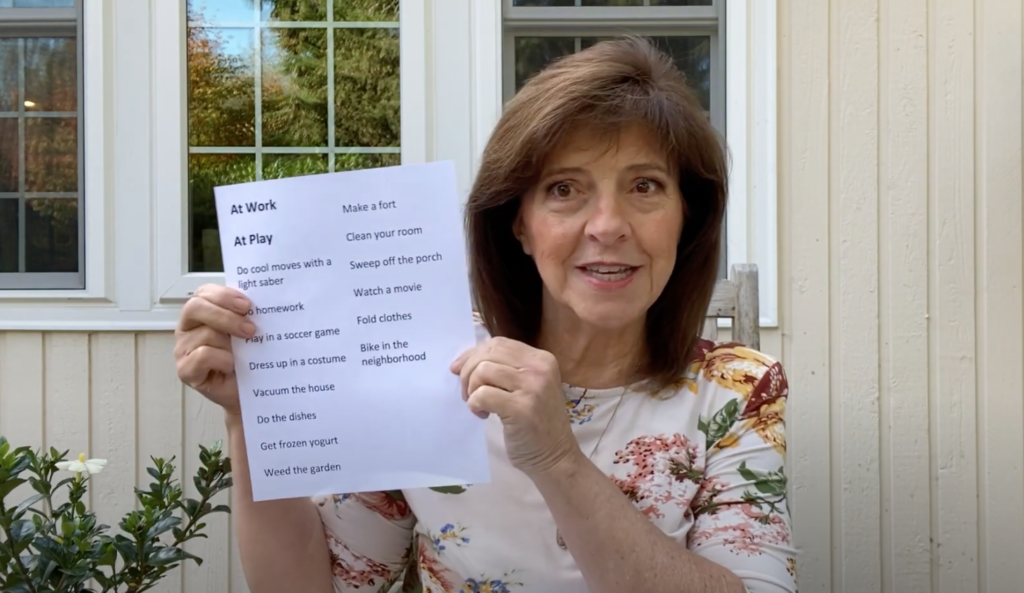
Checklist Countdown
You’ve met with the Primary presidency and decided the songs the children will be singing for the program. Check?
You’ve been teaching the first verses of each of the songs for the program throughout the year and you are starting to review them (ideas for review here and here and here). Check? (If you have taught second verses, perhaps a small group of children could sing that in the program so it doesn’t take up more time in the review AND the children don’t mix up the two verses. I practice with the small groups separately.)
You have found out from the Primary presidency (who talked with the Bishopric) when the Primary program is scheduled in Sacrament meeting. Check?
Now the work of the presentation begins….
I propose (having seen and helped with more than 20 programs) that the children really do not like the Primary program practices very much. I have seen that it is the adults who need the rehearsal, but it is negative for the children. So…I propose that the adults need to do much of the preparation beforehand without involving the children! It makes for much happier children and a better experience. The most successful practices can be a ONE time happening to get essentials down (listed below), plus some practicing of speaking and singing in the regular Primary time. (I have done this in multiple wards and seen it work.) I offer that suggestion here for you.
Let’s divide this into two parts:
- What is essential for the children?
- What is essential for the adults to help the children?

The Children
- They need to feel confident in singing the songs (especially because it will be in front of a lot of people).
- They need to know where to sit on the stand so that they have a home base where they are “safe.”
- They need to know when to stand up and sit down in order to sing the songs.
- They need to know what they will be saying at the mic for a speaking part and then have a chance to practice that at a mic. (Without, I might add, having to listen to ALL the speaking parts at one time. I’ve seen the children’s eyes glaze over because they are not challenged, don’t really want to listen, and they have to sit still for such a long time.)
- They need to know when to come to the mic for a speaking part and then how (which path) to go back to their seat.

The Adults
- They need to feel confident in singing the songs. Yes, the teachers need to memorize the songs so that they are looking at the conductor.
- They need to know where the children will be sitting (so that they can help) and where they will be sitting. Which is the teacher’s chair? Where do the members of the presidency sit during the program so that they can help? Where does the Bishop sit? Where does the music leader sit so the children can see her when she stands to conduct?
- They need to know when the children will be standing and sitting to sing, again so that they can help remind the children to stand. Is there a printed outline of the program with the songs in bold so that the adults can help?
- They need to know how to help the children get to the mic to say their parts and how to get back to their seats. Is there a printed program for the teachers? Has the presidency worked out the “flow” of coming to and going away from the mic without congestion? (Again, the children really dislike being pawns in these decisions. Make the decisions before the children are ever on the stand.)
- They need to know when to cue the children to go to the mic for a speaking part and someone needs to be the support at the mic with a printout of what each child is saying. Once again, is there a printed program so that the teachers and presidency can help the children? Which presidency member is the mic support?
The Prep Before – Check?
- The Primary Music Leader thoroughly prepares both the teachers and the children in the 7, 8, or 9 songs that will be sung in the program during regular Singing Time. (This is not drilling words. It is doing 4 or 5 different activities with each song, then doing review activities. We want the children to have great feeling about the songs!)
- The Primary presidency creates a seating chart and a flow chart of how the children will come to the mic and then sit down when it is their turn to speak. (This is planning that is done without any child participation.) They make a copy of the seating chart and during the ONE practice (see below), hand it out to the teachers. Part of the purpose of that ONE practice is to show the children where to sit. (The Primary presidency has already worked with the children by handing out speaking parts a month or two before and knows when they will come to the mic.)
- During the ONE practice, the children stand to sing and sit in the flow of the program so they know what is expected. (This is NOT something that takes a lot of practice. In fact, the children really dislike doing this for more than one practice.)
- The Primary presidency schedules time in regular Primary for each child that is speaking to “give” their part in the presentation at the mic as a normal part of Primary, sometimes two talks per week. That way the children have practiced speaking in front of people at the mic (although not in the chapel). The Primary presidency decides which of the four of them will be support at the mic when the program comes and has a copy of the printed program.
- The teachers, presidency, and music leader each have a copy of the printed program so that they know when to cue their children to go to the mic and when each song will be sung. This includes any special groups that are going to be singing second verses or other groups solos.
The ONE practice
Because the children have already practiced their parts at the mic in the Primary room and because the children and teachers already know the songs, all we really need to practice in the ONE practice is:
- where to sit on the stand
- when to stand and sit in order to sing the songs
- when to stand to go to the mic for a speaking part and how to get back to their seats
So those are the things we practice! And here’s some ideas…
- Have only ONE rehearsal with all the children. In that rehearsal the children and teachers learn where they will be sitting (that means the seating chart is already made and the teachers have a copy). Part of the rehearsal is calling each class up to the stand one by one and having them sit in their chairs, leaving room for missing children. Instruct the teachers where to move if several children do not show up the day of the program.
- In that rehearsal (after each finding where they will sit) the children come up to the mic in the order they will be speaking, but they don’t give the talk. They’ve already practicied it in regular Primary, so they just say their name and go according to the flow chart (which is already done) back to their seats.
- In that rehearsal the children and teachers learn which song comes first, second, third, etc. because you sing part of the song as it comes in the program. The children come to the mic and you sing the song where it comes in the rehearsal, … but they don’t sing the whole song! The introduction to the song is played, they stand at the music director’s signal, they sing the first two lines, and then they STOP singing!? (It leaves the children actually wanting more instead of getting bored with singing.) The music director seats them after they STOP (which is part of what they are practicing) and then the program moves onto the next speaker. It takes less time in the rehearsal, the children are left wanting more, but both the teachers and the children know which song comes next, plus how to stand and be seated.
The confidence to actually do the practice this way
I know it sounds “scary” to do a practice for the program this way, but I promise it works.
The benefits?
- The program runs quite smoothly because the before work has been done. (Being realistic, we are human and we are working with children, so there are always a few surprises.?)
- The children do not come to dislike the program practices, they are not bored so easily, and they have a better attitude.
- The adults like the program practice better, also! The presidency will always be on high alert no matter how many practices you have, but they too have a better experience because there are MUCH fewer behavior problems. (Bored children often make their own excitement.)
Blessings and much love as you work with our precious children to sing the songs that hopefully go deep into their soul. Often the ward members are very touched by the presentation. Recognize, though, that many of your tender moments as a music leader with the children will come in your regular Primary Singing time.

Rosanne Patterson
Love this Sharla! And having been a PP 3 times, I can testify that it works! Now I’m the primary music leader again, also for the third time!?
Something that has worked well for me to help prepare children for standing and sitting for each song has been to have “choir practice” occasionally, throughout the year, when we review a song. Here’s how it goes: -I review the rules:
-all eyes on me when you hear the music start
-feet on the floor, hands in your lap
-watch me – stand TOGETHER when I raise you
-have pianist play intro, raise children, then say, “hands to your sides, eyes on me”
-sing the song; then whisper “watch me!”
-motion children to sit down together
It takes a little practice, but they get it, and doing it occasionally throughout the year helps them to know what the expectations are when program time rolls around. HTH!!
Paola Hernández
Thank u Sister! Are a super cool ideas! I’m from Mexico and I taken for my primary ward! Xoxo!
Haley
Thank you Sharla!
Because I really need review ideas and I’m sure others do too…I wanted to make you aware that your first two links for review ideas don’t work (in the beginning of this post). I figured out that the “t” was missing on the link…
teachingprimarymusic…. Added that missing T and went perfectly to the correct page.